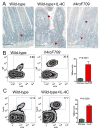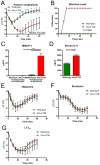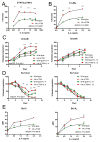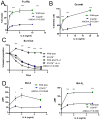Direct effects of IL-4 on mast cells drive their intestinal expansion and increase susceptibility to anaphylaxis in a murine model of food allergy
- PMID: 23149659
- PMCID: PMC3600405
- DOI: 10.1038/mi.2012.112
Direct effects of IL-4 on mast cells drive their intestinal expansion and increase susceptibility to anaphylaxis in a murine model of food allergy
Abstract
Interleukin (IL)-4 has critical roles in allergic disorders, including food hypersensitivity. The direct effects of the cytokine on the survival and function of mast cells, the key effectors of food anaphylaxis, have not been established. In this study, we demonstrate that IL-4 induces a marked intestinal mastocytosis in mice. This phenotype is reproduced in animals expressing Il4rαF709, an activating variant of the IL-4 receptor α-chain (IL-4Rα). Il4rαF709 mice exhibit enhanced anaphylactic reactions but unaltered physiological responses to vasoactive mediators. IL-4 induces Bcl-2 and Bcl-X(L) and enhances survival and stimulates proliferation in cultured bone marrow-derived mast cells (BMMC). These effects are STAT6 (signal transducer and activator of transcription factor 6)-dependent and are amplified in Il4rαF709 BMMC. In competitive bone marrow chimeras, Il4rαF709 mast cells display a substantial competitive advantage over wild-type mast cells, which, in turn, prevail over IL-4Rα⁻/⁻ mast cells in populating the intestine, establishing a cell-intrinsic effect of IL-4 in intestinal mast cell homeostasis. Our results demonstrate that IL-4-signaling is a key determinant of mast cell expansion in food allergy.
Conflict of interest statement
The authors state that they have no conflicts of interest. Research reported in this publication was supported by NIH/NIAID Grants R21AI087666 and R56AI100889 (HCO), T32AI007512 (OTB and JSZ), R01AI083516 (MFG), Department of Defense FA100085 (TAC) and by EPA Grant 83482501 (HCO).
Figures





References
-
- Branum AM, Lukacs SL. Food allergy among U.S. children: trends in prevalence and hospitalizations. NCHS Data Brief. 2008;(10):1–8. - PubMed
-
- Rudders SA, Banerji A, Vassallo MF, Clark S, Camargo CA., Jr Trends in pediatric emergency department visits for food-induced anaphylaxis. J Allergy Clin Immunol. 2010;126(2):385–388. - PubMed
Publication types
MeSH terms
Substances
Grants and funding
LinkOut - more resources
Full Text Sources
Other Literature Sources
Medical
Research Materials
Miscellaneous

